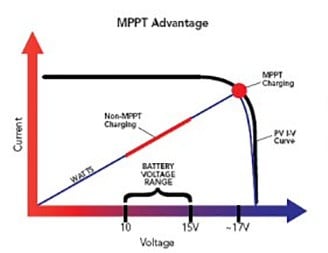The popular technology in some charge controllers called maximum power point tracking (MPPT) extracts additional power from your PV array, under certain conditions. This article explains the process by a mechanical analogy, for people who do not understand basic electricity.
The function of a MPPT is analogous to the transmission in a car. When the transmission is in the wrong gear, the wheels do not receive maximum power. That’s because the engine is running either slower or faster than its ideal speed range. The purpose of the transmission is to couple the engine to the wheels, in a way that lets the engine run in a favorable speed range in spite of varying acceleration and terrain.
Let’s compare a PV module to a car engine. Its voltage is analogous to engine speed. Its ideal voltage is that at which it can put out maximum power. This is called its maximum power point. (It’s also called peak power voltage, abbreviated Vpp). Vpp varies with sunlight intensity and with solar cell temperature. The voltage of the battery is analogous to the speed of the car’s wheels. It varies with battery state of charge, and with the loads on the system (any appliances and lights that may be on). For a 12V system, it varies from about 11 to 14.5V.
In order to charge a battery (increase its voltage), the PV module must apply a voltage that is higher than that of the battery. If the PV module’s Vpp is just slightly below the battery voltage, then the current drops nearly to zero (like an engine turning slower than the wheels). So, to play it safe, typical PV modules are made with a Vpp of around 17V when measured at a cell temperature of 25°C. They do that because it will drop to around 15V on a very hot day. However, on a very cold day, it can rise to 18V!
What happens when the Vpp is much higher than the voltage of the battery? The module voltage is dragged down to a lower-than-ideal voltage. Traditional charge controllers transfer the PV current directly to the battery, giving you NO benefit from this added potential.
Now, let’s make one more analogy. The car’s transmission varies the ratio between speed and torque. At low gear, the speed of the wheels is reduced and the torque is increased, right? Likewise, the MPPT varies the ratio between the voltage and current delivered to the battery, in order to deliver maximum power. If there is excess voltage available from the PV, then it converts that to additional current to the battery. Furthermore, it is like an automatic transmission. As the Vpp of the PV array varies with temperature and other conditions, it “tracks” this variance and adjusts the ratio accordingly. Thus it is called a Maximum Power Point Tracker.
What advantage does MPPT give in the real world? That depends on your array, your climate, and your seasonal load pattern. It gives you an effective current boost only when the Vpp is more than about 1V higher than the battery voltage. In hot weather, this may not be the case unless the batteries are low in charge. In cold weather however, the Vpp can rise to 18V. If your energy use is greatest in the winter (typical in most homes) and you have cold winter weather, then you can gain a substantial boost in energy when you need it the most!
Here is an example of MPPT action on a cold winter day:
Outside temperature: 20°F (-7°C) Wind is blowing a bit, so the PV cell temperature rises to only around 32°F (0°C).
Vpp = 18V Batteries are a bit low, and loads are on, so battery voltage = 12.0
Ratio of Vpp to battery voltage is 18:12 = 1.5:1
Under these conditions, a theoretically perfect MPPT (with no voltage drop in the array circuit) would deliver a 50% increase in charge current! In reality, there are losses in the conversion just as there is friction in a car’s transmission. Reports from the field indicate that increases of 20 to 30% are typically observed.



